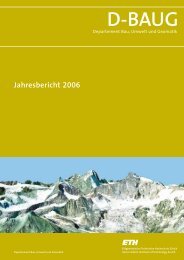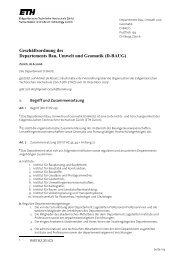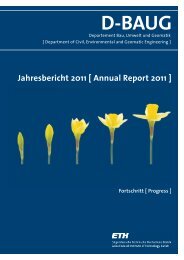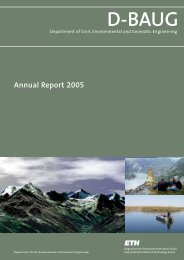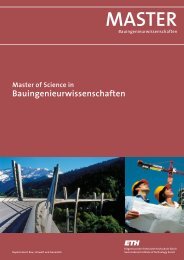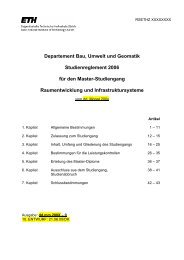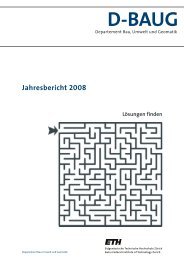D-BAUG - Departement Bau, Umwelt und Geomatik - ETH Zürich
D-BAUG - Departement Bau, Umwelt und Geomatik - ETH Zürich
D-BAUG - Departement Bau, Umwelt und Geomatik - ETH Zürich
You also want an ePaper? Increase the reach of your titles
YUMPU automatically turns print PDFs into web optimized ePapers that Google loves.
Key Article ▪ Rüdlingen Monitoring and Landslide Experiment<br />
slope (Fig. 8), where less influence was expected from the<br />
vegetation and a rising gro<strong>und</strong>water table would be possible.<br />
Roots were severed to a depth of 40 cm along the sides<br />
of the field and more extensive tracer / run-off experiments<br />
were planned for a follow-up experiment in March<br />
2009 over 2 weeks, so that saturation could be achieved<br />
prior to initiating failure.<br />
Pre-test predictions of a failure event were as follows: a<br />
landslide would be triggered towards the end of the first<br />
week, it would be initiated in the top right quadrant, and<br />
travel towards the bottom right of the field, with a failure<br />
surface at a depth of about 1.5 m, mobilising between<br />
100–300m 3 of debris.<br />
With newly aligned sprinklers, the rainfall was adjusted to<br />
an average distribution of 15 mm/h. There was an instant<br />
response in the upper part of the field as the saturation degree<br />
increased, suctions dropped and then the water table<br />
rose over 5 h to about 1.5 m below gro<strong>und</strong> level, where it<br />
stayed for the next 10 h. 15 h after the rainfall had begun,<br />
at 3:00 am, the upper right quadrant started to creep<br />
downslope, with the rate increasing until 3:23 am (Fig. 9).<br />
A crack opened up parallel to the top of the test field, and<br />
as the failure surface spread through the gro<strong>und</strong>, the right<br />
hand side of the landslide followed the scar made through<br />
the vegetation and the left ripped away from and through<br />
the surficial vegetation (Fig. 10). It took 36 seconds to mobilise<br />
about 130 m 3 (3 super script) of soil and roots, which<br />
travelled left towards the tree stump in the lower part of<br />
the field, which re-directed the flow to accelerate towards<br />
the bottom right, whereupon it took only 12 seconds more<br />
to impact on the protection net. Not one grain of debris<br />
reached the forest road below (Fig. 11). Water oozed out of<br />
the back scarp for several minutes after the event and the<br />
research team celebrated ‘a bonnie slide’, which was quite<br />
well predicted in size and shape. The difficulty of estimating<br />
the time to failure was emphasised however.<br />
Lessons for the locals include that a cracked base rock is<br />
very effective at draining the overlying gro<strong>und</strong>, rather like<br />
trying to fill up a bath when the plug is not in! The challenges<br />
of slope instabilities lie when shallow soil layers<br />
overly semi-impermeable rock so that a water table can<br />
build up locally or even flow out of the gro<strong>und</strong>. Useful<br />
hints to such episodic springs can be obtained from vegetation<br />
and during winter from the build up of ice (Fig. 12).<br />
In general, vegetation has a very positive effect on slope<br />
stability, with tree roots acting as effective deep reinforcement,<br />
which could be quantified by the experiment.<br />
References.<br />
Askarinejad, A. (2009). A method to locate the slip surface<br />
and measuring subsurface deformations in slopes. 4th International<br />
Young Geotechnical Engineers' Conference,<br />
Alexandria, Egypt: 171-174.<br />
Casini, F., Jommi, C., Springman, S.M. (2010). A laboratory investigation<br />
on an <strong>und</strong>isturbed silty sand from a slope<br />
prone to landsliding. Granular Matter, in print, DOI:<br />
10.1007/s10035-010-0182-y.<br />
30 ▪ D-<strong>BAUG</strong> Annual Report 2009<br />
Colombo L. (2009) Large shear box for analysing strength<br />
mobilisation in unsaturated conditions. Master Thesis, Politecnico<br />
di Milano.<br />
Minder, P. (2008). Shear resistance of silty sand from the<br />
Rüdlingen monitoring and triggering test site. Semester<br />
thesis, <strong>ETH</strong>, Zurich.<br />
Springman, S.M., Kienzler, P., Casini, F., Askarinejad, A. (2009).<br />
Landslide triggering experiment in a steep forested slope<br />
in Switzerland. Proc. of the 17th Intern. Conf. on Soil Mech.<br />
and Geotech. Engin., Egypt, 5-9 Oct. IOS Press.<br />
Teysseire, P. (2006). Geotechnische Eigenschaften von Moränen.<br />
PhD dissertation <strong>ETH</strong> Zurich.<br />
Thielen, A. (2007). Einfluss der Bodensättigung auf die Stabilität<br />
von Hängen. PhD dissertation <strong>ETH</strong> Zurich.<br />
Acknowledgements:<br />
This research was partially f<strong>und</strong>ed by the Competence<br />
Centre for Environment and Sustainability (CCES) and<br />
the <strong>ETH</strong> Research F<strong>und</strong>, within the framework of the<br />
TRAMM Project. Geobrugg AG, Canton Schaffhausen<br />
and Terr-Bohr AG are thanked for contributing as<br />
sponsors.<br />
We are grateful to the Rüdlingen Council, especially<br />
Mrs. Katy Leutenegger (President) and Martin Kern,<br />
the fire station, the farmers, foresters and communities<br />
of Rüdlingen and Buchberg.<br />
Fatih Akdeniz, Mengia Amberg, Harald Bollinger, Rico<br />
Borellini, Cornelia Brönnimann, Louis Bugnion, Lorenzo<br />
Colombo, Matthias Denk, Sara Durot, Alfred Ehrbar,<br />
John Eichenberger, Francesca Gambazzi, Ralf Herzog,<br />
Martin Huber, Hilmar Ingensand, Markus Iten, Elena<br />
Kapogianni, Thomy Keller, Kubilay Kelesoglu, Lyesse<br />
Laloui, Jan Laue, Peter Lehmann, Anita Meyer, Gernot<br />
Michlmayr, Ferney Morales, Mathieu Nuth, Dani Or,<br />
Heinz Richner, Christian Rickli, René Rohr, Andreas<br />
Schmid, Massimiliano Schwarz, Manfred Stähli, Karl<br />
Steiner, Barbara Suski, Laurent Tacher, Axel Volkwein,<br />
Albrecht von Bötticher, Corinna Wendeler, Felix<br />
Wietlisbach and Adrian Zweidler are thanked for their<br />
contribution to this project.



